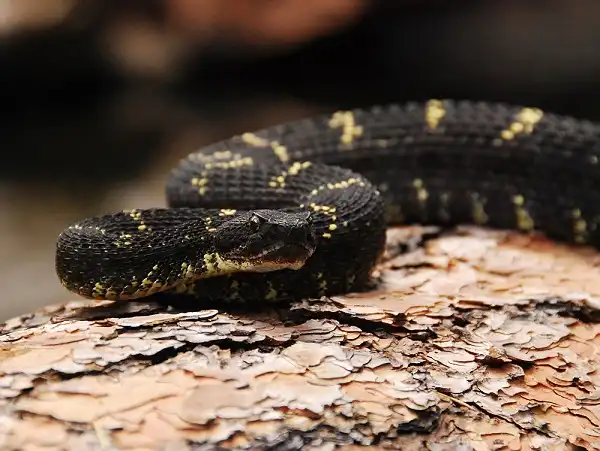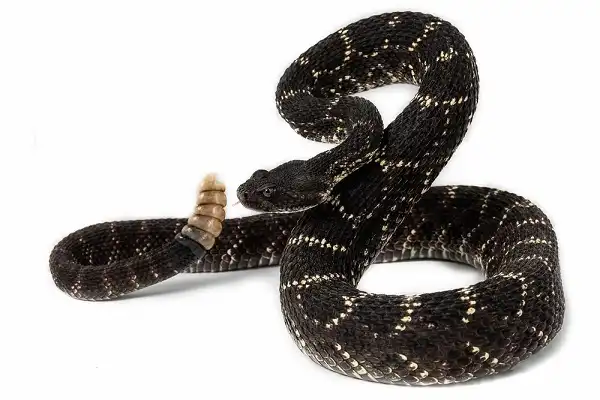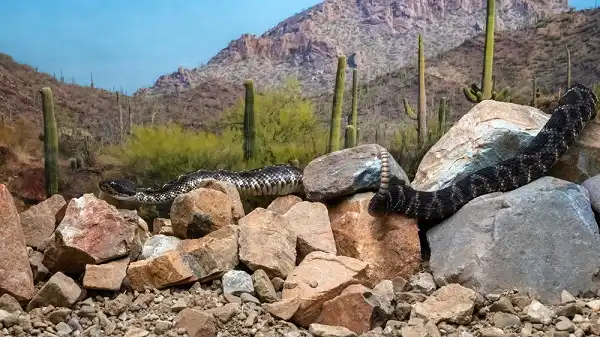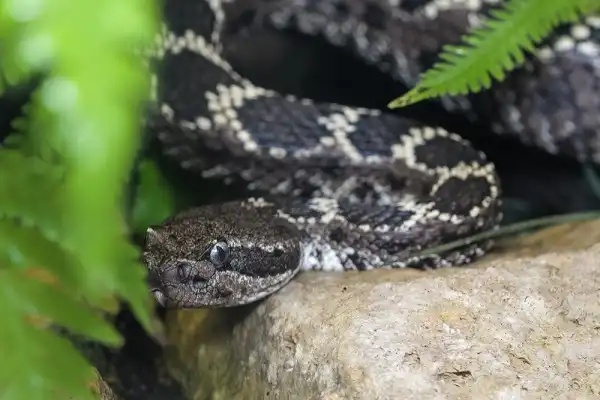If you’ve ever been hiking in the Southwestern United States, chances are that you’ve encountered an Arizona Black Rattlesnake. Not only is this snake highly venomous and potentially dangerous to humans, but it also plays a critical role in maintaining healthy ecosystems throughout its range. Join me as I explore the unique behaviors and biology of this important reptile, including where they live and how they interact with their environment.

Arizona Black Rattlesnake Description
The Arizona Black Rattlesnake is classified as a member of the Crotalus genus, which includes all rattlesnakes. Its body is marked with variable coloration including shades of black, brown, olive drab, and yellowish-tan. The snake’s dorsal scales are usually smooth and glossy. Along its back runs a distinctive row of 18–22 black or dark brown blotches bordered by white outlines; this pattern gives the species its name. The head of the Arizona Black Rattlesnake may be solid black, sometimes with light flecking on top; some specimens may feature additional yellow or orange markings on their heads. The Arizona Black Rattlesnake is easily identified by the presence of a distinctive “rattle” at the end of its tail. This rattle is composed of loosely interlocking segments which make a sound when vibrating rapidly.
Arizona Black Rattlesnake Habitat
The Arizona Black Rattlesnake prefers arid and semi-arid habitats with plenty of rocky outcroppings and other sheltered areas. They may inhabit deserts, hillsides, grasslands, woodlands, open scrubland, and other dry areas with adequate cover in the form of rocks or debris. Additionally, they can be found along rivers and streams that are not subject to flooding. Because of their wide range across the Western United States, their habitat preferences may vary slightly according to location. In northern regions of the species’ range such as Nevada and Utah, rattlesnakes tend to find shelter in crevices on cooler rocky outcroppings that offer some protection from extreme temperatures during both summer and winter months.
In southerly regions such as Arizona, New Mexico, Texas, and California they often inhabit dry washes lined with boulders which provide excellent cover for prey animals like small rodents or lizards. They may also take up residence in artificial structures like abandoned buildings or even burrows made by other animals if conditions are suitable. During the day Arizona Black Rattlesnakes typically take shelter from the sun beneath rocks or logs which offer ample shade; at night they will move around actively hunting for food under cover of darkness. As nocturnal predators, they use their excellent vision to detect movement from potential prey items while using their sensitive heat-sensing organs (called pit organs) to locate warm-blooded prey even in complete darkness.

Arizona Black Rattlesnake Diet
The Arizona Black Rattlesnake is an opportunistic feeder and will consume a variety of animals including small mammals, reptiles, birds, and even amphibians. The majority of its diet consists of rodents such as mice, rats, ground squirrels, gophers, and voles. Other prey items may include lizards, small snakes, birds, or even frogs. Juvenile rattlesnakes have been observed consuming invertebrates such as spiders or centipedes. Active feeding periods usually occur predominantly during the night hours when ambient temperatures are cooler; however, in certain parts of its range, this species will hunt during the day when temperatures become particularly hot in order to avoid overheating. During summer months they tend to feed more at night and will retreat beneath rocks or logs during daylight hours in order to conserve energy and prevent dehydration in their arid environment.
Arizona Black Rattlesnake Size
The Arizona Black Rattlesnake is a medium-sized rattlesnake species, typically reaching lengths of up to 4 feet. They can be identified by their unique black or dark gray coloration which serves to camouflage them in their rocky desert habitats. The body of the Arizona Black Rattlesnake is slightly flattened in shape and they have a distinct rattle at the end of its tail which produces a loud buzzing sound when threatened or disturbed. Their heads are typically marked with distinctive patterns of dark spots and stripes, helping them blend into their natural environment. On average, an adult Arizona Black Rattlesnake will weigh between 1 and 2 pounds but heavier individuals have been documented in certain areas. Females tend to be larger than males and may reach lengths up to 5 feet long. Hatchlings are usually around eight inches long at birth and will usually double in size within their first year of life.
Arizona Black Rattlesnake Lifespan
The Arizona Black Rattlesnake is a long-lived species, with individuals capable of living for up to 20 years in the wild. In captivity, they can live even longer; one particular specimen lived for over 34 years! The age at which an Arizona Black Rattlesnake reaches sexual maturity depends on factors such as geographic location and environmental conditions, with most reaching sexual maturity by 4-5 years old. As with most rattlesnakes, the Arizona Black Rattlesnake exhibits indeterminate growth, meaning that it continues to grow throughout its lifespan until death. This allows it to become larger over time and meet the demands of its environment as food resources change or competition increases. During colder months when prey is scarce or temperatures drop below their preferred range, Arizona Black Rattlesnakes will enter a state of brumation (similar to hibernation) in order to conserve energy and reduce metabolic activity. During this period their metabolism slows significantly and they remain dormant until conditions improve and the weather warms up again. This helps them survive cold winter months without depleting their energy reserves or starving before spring arrives.

Arizona Black Rattlesnake Behavior
The Arizona Black Rattlesnake is a relatively docile species and will often attempt to flee rather than attack potential predators. When threatened, they may coil up tight in an attempt to look bigger while producing a loud rattle to warn off any attackers. If cornered or grabbed, they may bite defensively with their powerful jaws and sharp fangs. In terms of social behavior, Arizona Black Rattlesnakes are generally solitary animals; however, during the mating season, males will compete with each other for mates. During this time males may be seen chasing one another around in an effort to gain dominance over a female’s territory. After mating, the female rattlesnake will typically give birth to live young from September through November. Arizona Black Rattlesnakes are diurnal hunters, meaning that they hunt during daylight hours when temperatures are cooler. They can travel long distances in search of prey and have been known to climb trees and shrubs in some parts of their range. During summer months they tend to feed more at night and will retreat beneath rocks or logs during daylight hours in order to conserve energy and prevent dehydration in their arid environment.
Arizona Black Rattlesnake Speed
The Arizona Black Rattlesnake is a fairly agile species and can move quickly when needed. In open terrain, they are capable of traveling at speeds up to 6 miles per hour. They have also been known to reach higher bursts of speed over short distances when threatened; some reports suggest that they can achieve speeds up to 11 miles per hour in such cases. In addition to its speed on land, the Arizona Black Rattlesnake is also an adept swimmer and can cover long distances in bodies of water if necessary. When swimming, they use their bodies to undulate through the water with surprising agility and maneuverability for a snake. Reports suggest that these snakes can travel up to 1 mile per hour in the water, making them surprisingly swift swimmers compared to other snakes of similar size and shape.
Arizona Black Rattlesnake Hunting
The Arizona Black Rattlesnake is an adept hunter that uses its speed and agility to pursue its prey. They primarily hunt small rodents such as mice and voles, but they also feed on birds, lizards, amphibians, and even other snakes. When hunting they typically ambush their prey from hiding places such as logs or rocks, striking quickly with their powerful jaws and sharp fangs before the victim can escape. In some cases, the rattlesnake will actively pursue its prey instead of waiting for it to come close. This usually happens when the snake is after larger prey like rabbits or hares, which require more effort to capture than smaller animals. In these cases, it will coil up tightly in an S-shape pattern before launching itself forward with remarkable speed to catch its target. The Arizona Black Rattlesnake can also use its burrowing ability to actively seek out prey underground. It does this by digging shallow tunnels just below the surface of the ground before flicking out its tongue to detect any nearby sources of warmth that may indicate hidden animals. Once found, it will then use its powerful jaws and sharp teeth to capture and kill the unfortunate creature before consuming it whole.

Conclusion
The Arizona Black Rattlesnake is an impressive species that displays remarkable speed, agility, and strength in order to survive and thrive in its arid environment. It is adept at both land-based and aquatic hunting thanks to its quick reflexes, small claws, and powerful jaws with sharp fangs. While relatively rare due to its reclusive nature, this species should be respected rather than feared as it plays an important role in maintaining the balance of nature within its range. With increased conservation efforts, the Arizona Black Rattlesnake can continue to thrive for many years to come!
Frequently Asked Question


